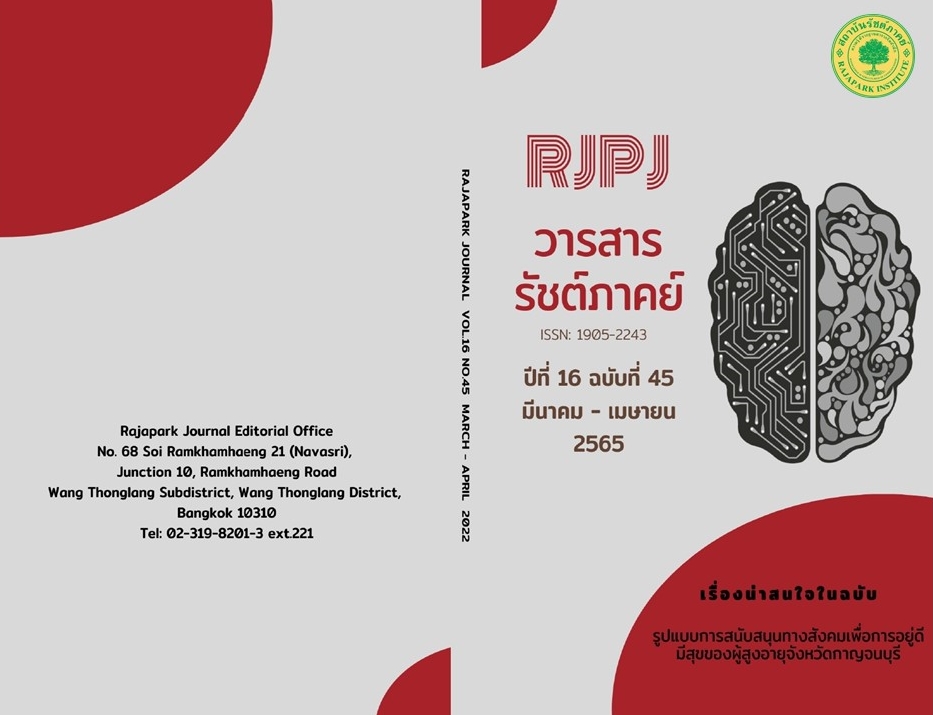A Factor Analysis of Online Content for Violence Prevention among Adolescents
Main Article Content
Abstract
This research aimed to 1) study the problem conditions of violence prevention among adolescents and 2) analyze the factors of online content for violence prevention among adolescents. The research was survey research. The population and sample were derived by purposive sampling. The informants were students, teachers, school administrators, and officers of organizations campaigning for violence prevention. The instrument used was a structured interview form about problem conditions and needs of online media for violence prevention for adolescents. Data were analyzed by segmenting, coding, and classifying for the main points. The research results can be concluded that: 1) the conditions and factors of violence in society at present tend to increase among adolescents, families, and schools. The problems were: lack of understanding of teenage development, lack of skills and positive communication, lack of understanding of causes of problems, lack of skills of assistants, including mental disorders; 2) analyze the factors of online content. The media suitable for violence prevention are online media, which are easy to access and follow. The content should be appropriate to gender and age, and give the information to adolescents, families, teachers, and school administrators, which can be divided into the development of adolescents, a skill for violence prevention, positive communication, an understanding of the causes of violence, and the skills of helpers.
Article Details

This work is licensed under a Creative Commons Attribution-NonCommercial-NoDerivatives 4.0 International License.
Views and opinions appearing in the Journal it is the responsibility of the author of the article, and does not constitute the view and responsibility of the editorial team.
References
Bangkokbiznews. (2018, July 29,). Family Violence Statistics Increased by 83%. Retrieved January 11, 2021, from https://www.bangkokbiznews.com/news/detail/808864
Dhanasobhon, S., Pilanthananond, N., Chongchaikit, M., & Sangjun, W. (2008). Development of Electronic Learning Resources on Violence Prevention for the Adolescents: Final Research Report. Bangkok: Kasetsart University.
Gunmintra, C. (2019). Domestic Violence Problems and Prevention. Bangkok: Rangsit University.
Kaewsuksai, R., & Jussapalo, C. (2013). Online social network: Facebook usage for the learners’ development. Princess of Naradhiwas University Journal, 5(4), 195-205.
Kesa, S., & Jitpiromsri, S. (2017). Adolescent and Cultural Violent in Muang District, Satun Province. Parichart Journal, Thaksin University, 28(3), 154-166.
Lomchavakarn, P. (2021). The media aimed to reduce domestic violence. STOU Academic Journal of Research and Innovation, 1(1), 14-20.
Morris, J. R., Petrov, D. A., Lee, A. M., & Wu, C-T. (2004). Enhancer Choice in Cis and in Trans in Drosophila Melanogaster: Role of the Promoter. Genetics, 167(4), 1739-1747.
Prachatai. (2018, Nov 11). The One-Stop Crisis Center (OSCC) Reported that in 14 years, 247,480 Children and Women were Violently Attacked. Retrieved January 25, 2021, from https://prachatai.com/journal/2018/11/79659
Rattanajirapong, P. (2017). Factors Effecting the Violence Behavior of Male Students in Vocational College in Nakhon Pathom Province(Master of Arts). Silpakorn University.
Saengloetuthai, J. (2015). Research Instrument. Journal of Graduate School Sakon Nakhon Rajabhat University, 12(58), 13-24.
Sangchawee, P. (n.d.) Qualitative Research is Easier. Retrieved January 11, 2021, from https://slideplayer.in.th/slide/13635739/
Sata-anan, C. (1996). Peace Theory, Way of Culture. Bangkok: Komol Keemthong.
Social Development News Team. (2019, June 18). Unlocking Violent Behavior. Retrieved January 25, 2021, from https://www.thairath.co.th/news/local/1593806
Visanuyothin, T., & Aroonrung, P. (2013). Guidelines to Help Adolescents with Violent Behavior for Public Health Officer. Bangkok: Deenadoo Media Plus.


